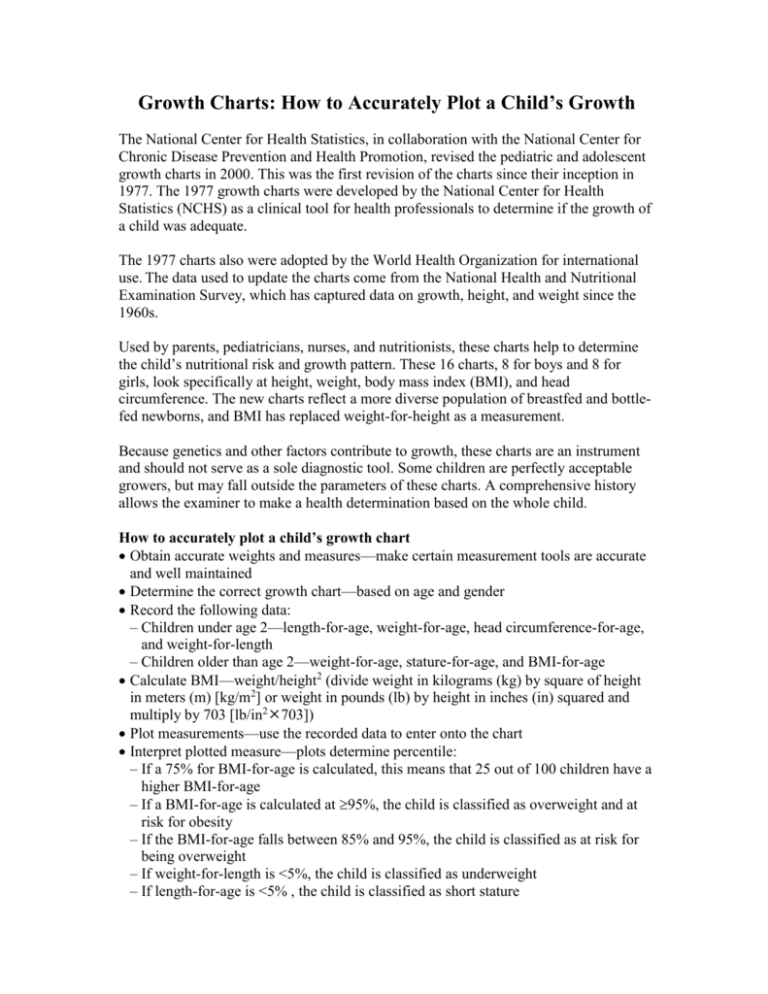Understanding Pediatric Growth Charts
advertisement

Growth Charts: How to Accurately Plot a Child’s Growth The National Center for Health Statistics, in collaboration with the National Center for Chronic Disease Prevention and Health Promotion, revised the pediatric and adolescent growth charts in 2000. This was the first revision of the charts since their inception in 1977. The 1977 growth charts were developed by the National Center for Health Statistics (NCHS) as a clinical tool for health professionals to determine if the growth of a child was adequate. The 1977 charts also were adopted by the World Health Organization for international use. The data used to update the charts come from the National Health and Nutritional Examination Survey, which has captured data on growth, height, and weight since the 1960s. Used by parents, pediatricians, nurses, and nutritionists, these charts help to determine the child’s nutritional risk and growth pattern. These 16 charts, 8 for boys and 8 for girls, look specifically at height, weight, body mass index (BMI), and head circumference. The new charts reflect a more diverse population of breastfed and bottlefed newborns, and BMI has replaced weight-for-height as a measurement. Because genetics and other factors contribute to growth, these charts are an instrument and should not serve as a sole diagnostic tool. Some children are perfectly acceptable growers, but may fall outside the parameters of these charts. A comprehensive history allows the examiner to make a health determination based on the whole child. How to accurately plot a child’s growth chart Obtain accurate weights and measures—make certain measurement tools are accurate and well maintained Determine the correct growth chart—based on age and gender Record the following data: – Children under age 2—length-for-age, weight-for-age, head circumference-for-age, and weight-for-length – Children older than age 2—weight-for-age, stature-for-age, and BMI-for-age Calculate BMI—weight/height2 (divide weight in kilograms (kg) by square of height in meters (m) [kg/m2] or weight in pounds (lb) by height in inches (in) squared and multiply by 703 [lb/in2703]) Plot measurements—use the recorded data to enter onto the chart Interpret plotted measure—plots determine percentile: – If a 75% for BMI-for-age is calculated, this means that 25 out of 100 children have a higher BMI-for-age – If a BMI-for-age is calculated at 95%, the child is classified as overweight and at risk for obesity – If the BMI-for-age falls between 85% and 95%, the child is classified as at risk for being overweight – If weight-for-length is <5%, the child is classified as underweight – If length-for-age is <5% , the child is classified as short stature – If head circumference-for-age is <5% or >95%, the child may have developmental problems All growth charts are available in black and white or color (in English and Spanish) on the Centers for Disease Control and Prevention’s Web site at http://www.cdc.gov/growthcharts. Children under 2 years of age should receive close monitoring, with several measurements taken annually. Children older than 2 years of age should receive annual measurements, which are sufficient to track growth for most healthy children. References and recommended readings Growth charts. Centers for Disease Control and Prevention Web site. http://www.cdc.gov/growthcharts/. Accessed March 29, 2013. Use and interpretation of the CDC growth charts. Centers for Disease Control and Prevention Web site. http://www.cdc.gov/nccdphp/dnpa/growthcharts/resources/growthchart.pdf. Accessed on March 29, 2012. Review Date 3/13 K-0517








